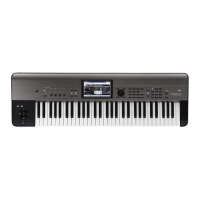Sequencer mode
144
•Alternatively, you could choose Track01 in Track Select
to run arpeggiator A for tracks 1 and 2, and use an
external MIDI device connected to the KROME’s MIDI IN
to send note data to MIDI channel 3 to play arpeggiator B.
The arpeggiator cannot be triggered by the notes
played by the sequencer.
If the track Status (Seq 3–1(2)c) is set to INT or BTH,
tracks 1–16 to which arpeggiator A or B are assigned
will be sounded by the note data generated by the
arpeggiator, regardless of the MIDI Channel (Seq 3–
1(2)c) setting of that track. If the track Status is set to
BTH, EXT, or EX2, the track will transmit MIDI note
data on the MIDI Channel of that track.
In this case, arpeggiator A or B will be triggered by the
MIDI Channel of any track 1–16 to which the
corresponding arpeggiator is assigned.
If the Local Control On (Global P1: 1–1a) is turned OFF,
the arpeggiator will not be triggered by note data from
the keyboard. It will be triggered by note data received
at MIDI IN. If you wish to record just the trigger notes
on an external sequencer and run the KROME’s
arpeggiator in this way, turn Local Control OFF.
If you want the note data generated by the arpeggiator
to be recorded on the external sequencer, turn Local
Control ON, and turn off the echo back function of the
external sequencer. (see p.368)
Arpeggiator Run A, B [Off, On]
When the ARP button is on, the arpeggiator(s) that are
checked here will function for the track(s) to which they are
assigned by Arpeggiator Assign.
When the arpeggiator is on, A and B can be turned on/off
independently.
V
7–1(2): Menu Command
•0: Memory Status see p. 163
•1: Exclusive Solo see p. 64
•2: Rename Song see p. 163
•3: Delete Song see p. 163
•4: Copy From Song see p. 163
•5: Load Template Song see p. 163
•6: Save Template Song (Save as User Template Song)
see p. 164
•7: FF/REW Speed see p. 164
•8: Set Location (Set Location for Locate Key) see p. 164
•9: GM Initialize see p. 165
•10:
Copy from Combination
see p. 166
• 11: Copy from Program see p. 101
• 12: Copy Arpeggiator see p. 66
For more information, please see “Sequencer: Menu
Command” on page 163.
7–3: Arpeggiator–A,
7–4: Arpeggiator–B
7–3(4)a: Location, Meter, Tempo, Tempo
Mode, Song Select, Track Select, Reso,
RPPR
7–3(4)b: Track Info
For more information, please see “0–1(2)a: Location, Meter,
Tempo, Tempo Mode, Song Select, Track Select, Reso, RPPR”
on page 109.
7–3(4)c: Arpeggiator–A(B) Setup
Pattern* [P0...P4, U0000(INT)...U0899(INT),
U0900(USER)...U1027(USER)]
Octave* [1, 2, 3, 4]
Resolution* [
, , , , , , , ]
Gate [000...100%, Step]
Velocity [001...127, Key, Step]
Swing [–100...+100%]
Sort* [Off, On]
Latch* [Off, On]
Key Sync.* [Off, On]
Keyboard* [Off, On]
These are the arpeggiator parameters for the song.
For more information, please see “PROG P7: ARP/DT
(Arpeggiator/Drum Track)” on page 53.
* These parameters can also be set from “0–5(6)c:
Arpeggiator A (B)”.
V
7–3(4): Menu Command
•0: Memory Status see p. 163
•1: Exclusive Solo see p. 64
•2: Rename Song see p. 163
•3: Delete Song see p. 163
•4: Copy From Song see p. 163
•5: Load Template Song see p. 163
•6: Save Template Song (Save as User Template Song)
see p. 164
•7: FF/REW Speed see p. 164
•8: Set Location (Set Location for Locate Key) see p. 164
•9: GM Initialize see p. 165
Pattern - B
Pattern - A
Pattern - A
Track2 MIDI Ch=2ch Status=INT
Arpeggiator
A
Arpeggiator
B
Arpeggiator
Assign
A
A
Pattern - A
Pattern - B
Trigger
= Ch1, Ch2
Trigger
= Ch3
Track3 MIDI Ch=3ch Status=INTB
Track1 MIDI Ch=1ch Status=INT

